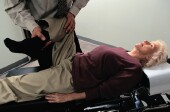- Skip Storing This Everyday Product in the Fridge Door
- Green Tea + B3 Pairing May Boost Brain Health
- Navigating Your Midlife Crisis: Embracing New Possibilities
- City Raccoons Showing Signs of Domestication
- Mapping the Exposome: Science Broadens Focus to Environmental Disease Triggers
- One Week Less on Social Media Linked to Better Mental Health
- Your Brain Changes in Stages as You Age, Study Finds
- Some Suicide Victims Show No Typical Warning Signs, Study Finds
- ByHeart Formula Faces Lawsuits After Babies Sickened With Botulism
- Switch to Vegan Diet Could Cut Your Greenhouse Gas Emissions in Half
Stroke Rates Declining Among Seniors, Study Shows


Seniors in America are suffering fewer strokes, regardless of their race or sex, a new long-term study reveals.
“We found that stroke incidence [among those 65 and older] has been declining for the last 20 years,” said senior study author Dr. Josef Coresh, a professor of epidemiology at the Johns Hopkins Bloomberg School of Public Health, in Baltimore.
“Our study found that the decrease is happening in whites and blacks, which is very important because blacks are at an elevated risk of stroke,” he added.
However, people younger than 65 continued to suffer strokes at about the same rate, although the researchers found that more of these younger patients survived their stroke.
The stroke death rate for people aged 65 and older held steady.
One expert found some of the study results troubling.
“The more concerning news is the lack of decline [in stroke rates] among those under 65,” said Dr. Ralph Sacco, chairman of neurology at the University of Miami Miller School of Medicine. “When you look at that statistic in relationship to recent warnings that diabetes, obesity and lack of physical activity are still major problems that have not been reduced in the last decade, this raises some red flags.”
As for the reduced death rate among younger stroke victims, “that may mean our ability to treat and improve survival after stroke is better in younger people,” Sacco said.
On the other hand, stroke rates likely are declining in older people due to improved treatment of risk factors for stroke, Coresh said.
For example, use of cholesterol-lowering medications increased from just under 4 percent to nearly 13 percent over time in these patients, with an accompanying decline in “bad” LDL cholesterol levels. At the same time, use of blood pressure medications increased from about 29 percent to 43 percent in that same period, an increase seen predominantly among people older than 65.
The number of current smokers also declined during the course of the study, the researchers noted.
The findings are published in the July 16 issue of the Journal of the American Medical Association.
Stroke ranks fourth among all causes of death in the United States, with about 800,000 Americans experiencing a stroke each year, according to background information that accompanied the study.
To study stroke rates in America, the researchers used results from the Atherosclerosis Risk in Communities study, which involved almost 16,000 residents of four U.S. communities who were between the ages of 45 and 64 when the study began in the late 1980s. The communities are Minneapolis, Washington County, Md., Forsyth County, N.C., and Jackson, Miss.
In this analysis, the researchers followed 14,357 participants who were free of stroke in 1987, looking specifically for all stroke hospitalizations and deaths between then and the end of 2011.
The study found a 24 percent overall decline in first-time strokes in each of the last two decades, and a 20 percent overall decrease per decade in deaths due to stroke.
The decline in overall stroke rates was driven largely by people 65 and older, while the decrease in stroke deaths occurred largely in people younger than 65, the researchers reported.
“Since rates are not equally falling across the board, physicians and policymakers need to pay closer attention to specific subgroups,” study author Silvia Koton, a visiting faculty member at the Johns Hopkins Bloomberg School of Public Health and incoming nursing department chair at Tel Aviv University, said in a news release from Hopkins.
“These data are also helpful in monitoring the results of how we care for people of all ages, hopefully helping them even before they have a stroke,” Koton added.
Coresh said the findings show that doctors have made some headway in fighting some of the worst health effects of obesity.
“It’s turning out that obesity has many adverse consequences through cardiovascular risk factors we understand,” he said. “We can treat blood pressure, and if we treat it early enough and aggressive enough we can lower the risk of stroke, and thereby blunt the risks of obesity.”
However, the fact that stroke rates remain stable among middle-aged Americans raises the possibility that the stroke rate among older people could again rise, as these adults enter old age after experiencing decades of obesity, he said.
“One should keep an eye on this because the maturing of the obesity epidemic could eventually still increase risk,” Coresh said.
More information
Visit the U.S. National Institutes of Health for more on stroke.
Source: HealthDay
Copyright © 2025 HealthDay. All rights reserved.










